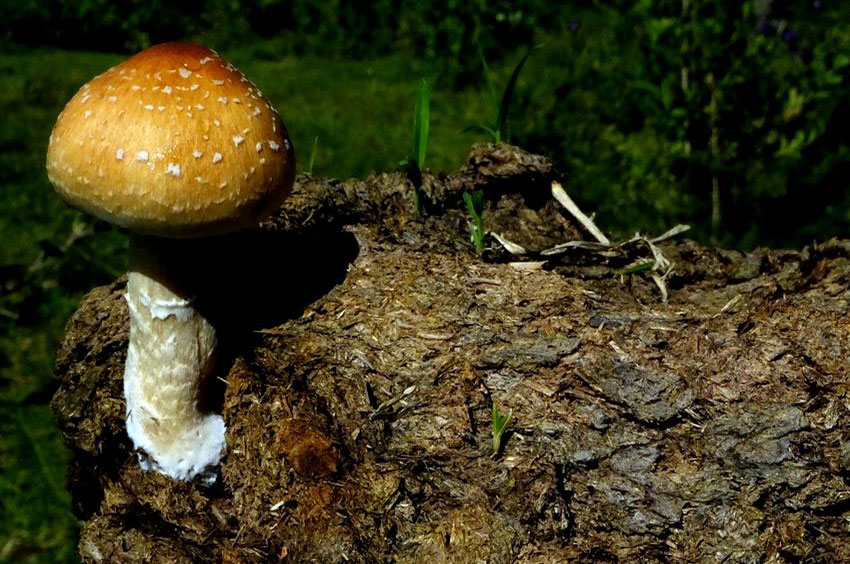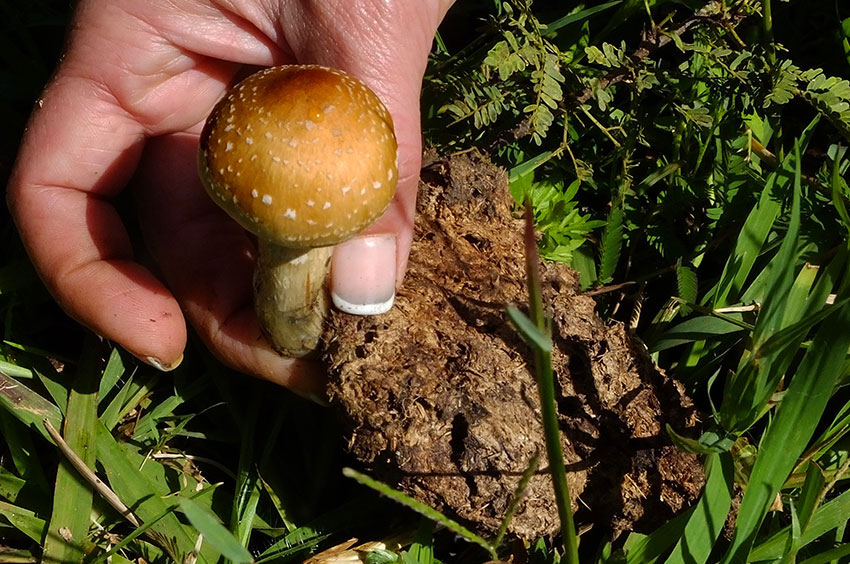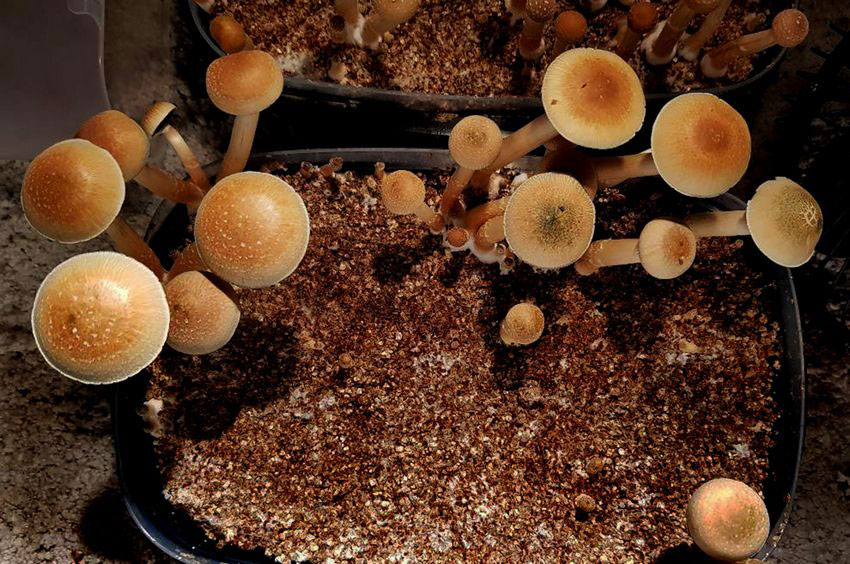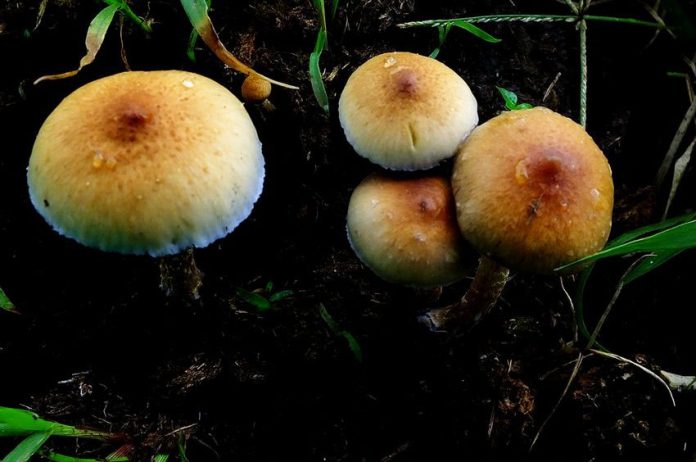The Mexican Psilocybin Society, an advocate for legalization of the active ingredient in magic mushrooms, is sponsoring a march in Mexico City September. John Pint reports that the group hopes to get psilocybin reclassified, opening the door for research into its use in combating anxiety and depression.
August is mushroom month in many parts of Mexico. Recently, while hiking across a meadow in the highlands of Jalisco, I came upon a person crouching in the middle of the trail, examining some small brown mushrooms that had sprouted in droppings left by a passing cow.
“Do you know something about mushrooms?” I asked.
“Well, I know something about this particular toadstool. This is Psilocybe cubensis and it’s world famous.”
At that, I pulled the mini-recorder out of my camera bag and asked if I could record what he was about to tell me.

“You can record me,” he said mysteriously, “but you can’t take my picture and you can’t use my name.”
“OK,” I replied, “so what about these toadstools?”
“They are known everywhere as magic mushrooms,” he said. “They contain a chemical called psilocybin that was first analyzed by Albert Hoffman, the Swiss scientist who isolated and studied LSD. These mushrooms are found all over the world . . wherever you find cow or buffalo pies.
“People who consume them say the ‘trip’ doesn’t show you pink elephants, but makes you feel loved and ‘cleans your heart.’ So, this mushroom typically changes people in a good way and there are studies to back this up. Here in Mexico it’s been used for 3,000 years for sacred and medicinal purposes and was called teonanácatl (god fungus) by the Aztecs.
“In the 1960s crowds of young people from the U.S. used to flock to the village of Huautla de Jiménez in Oaxaca’s Sierra Mazateca to see a curandera (healer) named María Sabina who was an expert in the use of these mushrooms. Eventually celebrities like John Lennon, Mick Jagger and Bob Dylan turned up. But all that publicity did its damage and poor María Sabina ended up being thrown out of her own community.
“Curiously, today the village of Huautla is known more for its deep caves than it is for its mushrooms.”

My source went on to tell me that a micro-dose of psilocybin has been found to be very effective in alleviating depression and anxiety.
“These doses are very, very small. They don’t induce a ‘trip’ but nudge the user in a certain, very beneficial direction. They represent an alternative to expensive and addictive anti-anxiety agents such as alprazolam (sold as Xanax and Tafil), for example.”
He told me that people who take these micro-doses gain a sense of what their body needs or does not need. Alcoholics, for example, might start asking why they’re drinking and decide to give it up.
“You start seeing problems from a new perspective, from above. And you no longer feel stressed. If there’s a solution, you use it; if there’s no solution, you forget about it. And your creativity goes sky high.
“. . . a person who feels depressed, who feels that life is not worth living, who doesn’t want to get out of bed, takes a micro-dose and everything changes. This person says, ‘Wow, do you see the colors of those flowers?’ You start to value all the things that are around you; all the things you were taking for granted. So, you start changing and little by little to realize you are leading a better life. And this, in turn, makes life better for the people around you.”
This was a big eye-opener for me. I realized my informant knew a lot about the effects of micro-doses of psilocybin on depression, so I asked if he could share some cases of people who had tried it.

“Yes, let’s take the case of someone we’ll call ‘Pepe Gonzalez’ . . . he had some issues . . . and decided to give it a try. After about three weeks, he said, ‘I don’t know if I’m going to continue to take this. I don’t feel any change.’ But his wife turned around and told him, ‘You stop taking those pills and I will divorce you on the spot!’”
My mushroom-expert friend continued: “I happened to speak to his son and mentioned that his father was taking psilocybin. ‘Oh ho!’ said the son, who was a very open-minded young man. ‘When did he start taking this? Three weeks ago, right?’ I told him that was exactly when his father had started and asked him how he knew. ‘Because,’ replied the son, ‘I saw a beautiful change in my father, a real transformation, and it started three weeks ago.’“
Psilocybe mushrooms can be found just about everywhere, but they are also classified as illegal just about everywhere. Nevertheless, a great deal of informal experimentation with them has gone on for some time. According to Scientific American, many psilocybin micro-dosers have reported that the mushrooms can increase creativity, calm anxiety, decrease the need for caffeine and reduce depression.
The website Pharmaceutical Technology reports that, in 2018, Compass Pathways, which studies psilocybin in treatment-resistant depression patients, “received the green light from the U.S. Food and Drug Administration for starting a . . . study with 216 patients, the largest clinical study ever done with psilocybin . . . . If successful, Compass will start a . . . trial with a view to file for approval in 2021.”
The report also cites a successful double-blind study at Johns Hopkins showing that some 80% of participants suffering from depression or anxiety enjoyed considerable relief for up to six months from just one dose of psilocybin.
“This,” says Pharmaceutic Technology, “is remarkable news considering that (most) depression medications on the market can take weeks or months to show effects, and sometimes these are modest and come with damaging side effects.”
[soliloquy id="88157"]
After learning about magic mushrooms, I was not at all surprised to read that the Mexican Psilocybin Society is sponsoring a march in Mexico City September 20 promoting legalization of psilocybin. It is now classified as a Type 1 drug — highly addictive and of no medical use. The group hopes to get it reclassified as Type 2, opening the door for research into its use in combating anxiety and depression.
If the society succeeds, raw materials for study will be easy to find. Many a time I have hiked to what I thought was the most inaccessible corner of Mexico and, just when I thought I was the only living creature in that remote spot, I would glance down and discover that I was standing in a cow pie.
The writer has lived near Guadalajara, Jalisco, for more than 30 years and is the author of A Guide to West Mexico’s Guachimontones and Surrounding Area and co-author of Outdoors in Western Mexico. More of his writing can be found on his website.
